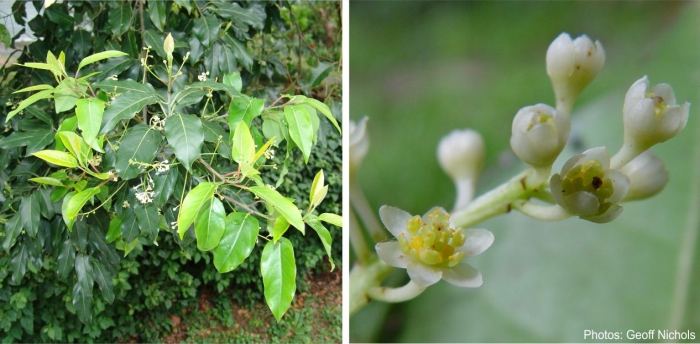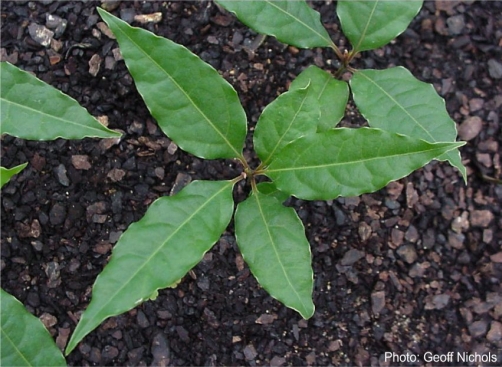Ocotea bullata
Ocotea bullata (Burch.) Baill.
Family: Lauraceae
Common names: stinkwood, black stinkwood, Cape laurel, (Eng), stinkhout, swartstinkhout, laurelhout (Afr), umnukani (Zulu), umhlungulu (Xhosa)
SA Tree No: 118
Introduction
The black stinkwood, or stinkwood as it is commonly known, is a large evergreen tree suitable for large gardens and parks. Along with yellowood, its timber was much sought after to make traditional Cape furniture.

Description
Description
This is a tall tree growing to 30 m in height. The leaves are dark and glossy green with blisters or bubbles on the upper surface, known as bullae, hence the specific epithet bullata. The leaf margins are wavy. It flowers from December to February, but sporadically later in the year in some places. Fruits in cups rather like those of the acorn follow the flowers. The wood is from light cream, through brown to almost black. It is also finely textured and fairly heavy.

Conservation Status
Status
South African Forestry Legislation as well as Nature Conservation Legislation protect this tree. In terms of the National Forests Act of 1998 protected species may not be cut, disturbed, damaged, destroyed and their products may not be possessed, collected, removed, transported, exported, donated, purchased or sold, except under license granted by the Dept of Water Affairs and Forestry.

Distribution and habitat
Distribution description
Ocotea bullata occurs naturally in most of the high forests of South Africa, from the kloofs of Table Mountain to the mountain forests of Limpopo, and it is at its best in the Knysna forests. According to Palmer and Pitman, it is seldom found in the forests on the Eastern Cape, where sneezewood occurs instead. It thrives in deep soils in kloofs. It has always been sought after for furniture and the bark collected for medicinal purposes. Only stumps and few saplings remain in Newlands forest (Table Mountain) and the bark is heavily stripped.
Derivation of name and historical aspects
History
According to Palmer and Pitman, Burchell recognized the stinkwood as a member of the family Lauraceae and named it Laurus bullata. The strange features on either sides of the midrib towards the base of the leaf are tiny swellings. The specific epithet bullata is a Latin word meaning 'knob' or 'bubble'. The genus name is derived the native name for Ocotea in Guiana. The common name stinkwood is derived from the unpleasant smell of the freshly cut wood.
This genus is represented by two species in southern Africa, Ocotea bullata and O. kenyensis.

Ecology
Ecology
Birds such as Rameron and the Delegorgue's pigeons and the Cape parrot favour the fruits of stinkwood.
Uses
Use
Africans use this tree medicinally, mostly the bark is used as a remedy for headache. The bark is used in various ways by traditional healers for urinary diseases and as an emetic for emotional and nervous disorders. The bark can also be drunk as tea or applied as steam to treat pimples. It is one of the top ten widely traded plants in South Africa.
Stinkwood is one of the most highly valued furniture woods, with many beautiful pieces made. It was also used for doors, windows, wagon parts and gun stocks.

Growing Ocotea bullata
Grow
This tree makes a lovely specimen for a large garden or a park. It is propagated from cuttings, but it has a low rooting success. The seed in the wild is parasitized and the regeneration potential is reduced. The seed must be picked, cleaned and sown immediately. The seed takes up to 30 days to germinate. This is a fairly fast growing tree if happy with its position, but stinkwoods are reported to be fussy and do not transplant easily (Palmer and Pitman). They prefer a shady forest situation.
References
- Nichols, G. 22 Nov 2002. Hunted by Herbalists- the stinkwood tree. Farmers Weekly.
- Van Wyk B & Van Wyk P, 1997, Field Guide to the trees of Southern Africa, Struik Publishers Cape Town.
- Palmer E & Pitman N, 1972, Trees of Southern Africa, A.A. Balkema, Cape Town.
- Thomas, M. Ocotea bullata -the feasibility of producing stinkwoods from cuttings. Veld & Flora 78(1):5.
Credits
Giles Mbambezeli
Kirstenbosch National Botanical Garden
March 2006
Images by Geoff Nichols
Plant Attributes:
Plant Type: Tree
SA Distribution: Eastern Cape, KwaZulu-Natal, Limpopo, Mpumalanga, Western Cape
Soil type: Sandy, Loam
Flowering season: Early Summer, Late Summer, Autumn
PH: Neutral
Flower colour: White, Cream
Aspect: Full Sun, Morning Sun (Semi Shade), Afternoon Sun (Semi Shade)
Gardening skill: Challenging
Special Features:
Horticultural zones









Rate this article
Article well written and informative
Rate this plant
Is this an interesting plant?
User Comments
Barker , South Africa
June 04, 2022 at 6:46 AMSuperb content, PZA never disapoints
Login to add your Comment
Back to topNot registered yet? Click here to register.